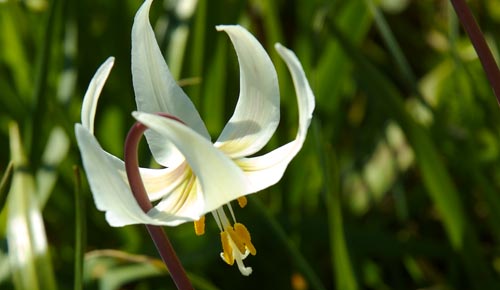Overview

White Fawn Lily, a native plant in Garry Oak ecosystems (photo by Emrys Miller / Rocketday Arts)
Garry Oak ecosystems contain some of Canada’s most endangered habitats and species, and they’re unique to this region. What can a single landowner or community group do to make a difference? Actually, quite a lot.
You can help save these ecosystems by making changes to the land you manage—be it a small yard or a large acreage—that will add to the beauty and value of the land and benefit the many plants and animals that rely on Garry Oak habitat.
We provide information on establishing, restoring and caring for Garry Oak habitat for:
- landowners
- volunteers or professionals helping a landowner or land manager
- members of a community group or school group who want to carry out a project in a park, a schoolyard or on other public land
Whether you are starting from scratch, or maintaining or enhancing what you already have, we have plenty of helpful ‘getting started’ information, practical tips and lists of resources for extra help. You’ll find basic information on ways to:
- beautify your garden with native plants
- plant and care for Garry Oak trees
- remove harmful invasive plants
- restore Garry Oak habitat
You can make a big difference! Much of the surviving Garry Oak habitat exists as small patches in private yards, gardens and rural lots, along with public lands. By restoring and caring for this habitat, even in a little corner of your property, you are helping to protect this natural treasure. And your efforts can have far-reaching positive effects; as others in your community and surrounding neighbourhoods protect and restore these areas, a patchwork quilt of connected Garry Oak habitats forms across your region. Many plants and animals in Garry Oak ecosystems need these connected habitats to survive and thrive.
Hundreds of volunteers and staff in parks, schools, and other public and private lands are working to remove invasive species and restore Garry Oak habitat. Consider visiting one of the many restoration projects and places to visit or joining a volunteer restoration crewto gain some knowledge and experience that could help you with your own project.
The Benefits
Native plant gardening has become popular in this region and it’s no wonder! A glance through any field guide to the flora of coastal BC offers up a lush selection of colourful plants with exquisite textures and shapes, all locally adapted to our fickle climate and generally acidic soils. What more could a gardener ask for in these days of climate uncertainty than a charming plant that is completely at home in this environment?
Native plant gardening is highly rewarding:
- Help conserve Canada’s natural heritage and create a healthy environment for your children and grandchildren by helping to bring back diversity of life to your neighbourhood
- Enjoy the beauty of your habitat’s attractive wildflowers, butterflies, mosses and birds
- Save on your water bills by replacing water-hungry lawns and ornamental gardens with water-thrifty native plants. Once native plants have become established, they require very little watering
- Save on your winter heating costs with well-placed trees for windbreaks and save on summer air conditioning costs with shade from trees
- Eliminate the need for harmful chemical fertilizers and herbicides by using native plants
- Watch your property values grow as trees mature and your easy-care native garden becomes more highly regarded
- Observe and learn from the fascinating diversity of life in your own backyard
- Improve your health from gardening and working in your yard and experience great satisfaction in your work
- Reduce maintenance chores such as mowing lawns, watering and replacing short-lived ornamental plants
When many people in an area choose to protect and restore Garry Oak habitats, the benefits are even greater. Neighbourhoods with plenty of greenspace are known to have lower turnover, creating a greater sense of community. And, when the time comes to sell, these properties usually sell very quickly and at higher prices. Natural areas also help to clean the air and water, and reduce flooding.
Spread the Word!
Let others know what you are doing and why it is so important.
- Install interpretive signs at the edge of the property so that people will know what you are doing.
- Talk to your neighbours. If you can get them interested, they may offer to help!
- If you are willing, you could offer tours to local naturalist and garden clubs, schools and other interested individuals.